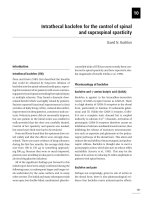Lecture Math for the pharmacy technician Concepts and calculations Chapter 5 – Lynn M. Egler, Kathryn A. Booth
Bạn đang xem bản rút gọn của tài liệu. Xem và tải ngay bản đầy đủ của tài liệu tại đây (2.21 MB, 44 trang )
Math for the Pharmacy Technician:
Concepts and Calculations
Egler • Booth
Chapter 5: Drug
Labels, Package
Inserts, and References
McGraw-Hill
©2010 by the McGraw-Hill Companies, Inc All Rights Reserved
Drug Labels and Package
Inserts
McGraw-Hill
©2010 by the McGraw-Hill Companies, Inc All Rights Reserved
5-2
5-3
Learning Objectives
When you have successfully completed Chapter 5, you will
have mastered skills to be able to:
Identify on a drug label the drug
name, form, dosage strength, route,
warnings, and manufacturing and
storage information.
Locate directions on drug labels and
package inserts for reconstituting
and diluting medications.
McGraw-Hill
©2010 by the McGraw-Hill Companies, Inc All Rights Reserved
5-4
Learning Objectives
(con’t)
Recognize different types of
tablets and capsules.
Distinguish administration routes
for medications.
Locate additional information in a
package insert.
McGraw-Hill
©2010 by the McGraw-Hill Companies, Inc All Rights Reserved
5-5
Introduction
Now that you have learned basic math,
equipment, and drug orders, it is time to
learn about drugs.
The drug label and package inserts contain
information that you need to perform
dosage calculations.
Be sure you know exactly what is on the
drug label.
Be sure to read the fine print.
McGraw-Hill
©2010 by the McGraw-Hill Companies, Inc All Rights Reserved
Locating Information on Drug
Labels and Package Inserts
Drug name
Form of the drug
Dosage strength
Total amount in the
container
Warnings
Route of administration
Storage requirements
Manufacturing information
McGraw-Hill
©2010 by the McGraw-Hill Companies, Inc All Rights Reserved
5-6
5-7
Drug Name
Generic name =
official name
By law this
name must
appear on the
label.
Trade name =
brand name used
to market the
drug
Levothyroxine
Levothyroxine Sodium
Sodium =
= Synthroid
Synthroid
(generic
(genericname)
name)
McGraw-Hill
(trade
(tradename)
name)
©2010 by the McGraw-Hill Companies, Inc All Rights Reserved
5-8
Drug Name
(con’t)
Registered mark® -- indicates the
name has been legally registered
with the U.S. Patent and
Trademark Office.
Several companies may
manufacture the same drug and
market it under different trade
names.
McGraw-Hill
©2010 by the McGraw-Hill Companies, Inc All Rights Reserved
5-9
Drug Name
(con’t)
You must know both the generic
and trade names of drugs.
Example
Vicodin® is a narcotic painkiller
Generic name: hydrocodone bitartrate
and acetaminophen
Other trade names: Anexsia®, Lortab®,
Zydone®
McGraw-Hill
©2010 by the McGraw-Hill Companies, Inc All Rights Reserved
5-10
Form of the Drugs
Solid oral medications
Liquids
tablets, capsules, gelcaps, caplets
oral, injections, inhalants, drops, sprays,
mists
Other
ointments, creams, lotions, patches,
suppositories, shampoos
McGraw-Hill
©2010 by the McGraw-Hill Companies, Inc All Rights Reserved
5-11
Dosage Strength
Drug labels include information about the
amount of drug present.
This amount combined with information
about the form, identifies the drug’s dosage
strength.
Note: Dosage strength is stated as amount of
drug per dosage unit.
Grams (g), milligrams (mg), micrograms
(mcg), or grains (gr) or Units
McGraw-Hill
©2010 by the McGraw-Hill Companies, Inc All Rights Reserved
5-12
Dosage Strength
(con’t)
Solid medications
Dosage strength is the amount of drug
present per tablet, capsule, or other form
McGraw-Hill
©2010 by the McGraw-Hill Companies, Inc All Rights Reserved
5-13
Dosage Strength
(con’t)
Liquid medications
Dosage strength is the amount of drug
present in certain quantity of solution
You need to know both the amount of drug
and the amount of total solution
Amount of solution varies per dosage unit
Pharmaceutical companies manufacture
meds with dosage strengths that match
commonly prescribed drugs
McGraw-Hill
©2010 by the McGraw-Hill Companies, Inc All Rights Reserved
5-14
Combination Drugs
Generic names and dosage strengths of
all components of a combination drug
must appear on the label.
All combination drugs have a trade name
that is usually used in drug orders.
Lortab® 5/500 1 tab q 4-6 h PRN for pain
(Lortab® contains 5 mg hydrocodone bitartrate and
500 mg acetaminophen)
McGraw-Hill
©2010 by the McGraw-Hill Companies, Inc All Rights Reserved
Total Number or Volume in
Container
Many oral meds are packaged in unit
doses
a single tablet
vial with 2 mL of solution for injection
Multiple-dose containers
one container with 50 gelcaps
Nonprescription medication
often packaged in multiple-dose containers
McGraw-Hill
©2010 by the McGraw-Hill Companies, Inc All Rights Reserved
5-15
Total Number or Volume in
Container (con’t)
Do not confuse the total amount of
drug in the container with the
dosage strength.
The container may hold 100 tablets
and each tablet has a dosage
strength of 2.5 mg per tablet.
McGraw-Hill
©2010 by the McGraw-Hill Companies, Inc All Rights Reserved
5-16
5-17
Route of Administration
Directions for the route of
administration may be
specified on the label.
If a tablet or capsule is
not swallowed, additional
information will be
provided.
Label will indicate
injection route.
McGraw-Hill
©2010 by the McGraw-Hill Companies, Inc All Rights Reserved
5-18
Route of Administration
(con’t)
Tablets/Capsules
orally
sublingually
chewable
Liquids
orally
injection
McGraw-Hill
©2010 by the McGraw-Hill Companies, Inc All Rights Reserved
5-19
CAUTION!
Give the right medication
by the right route.
Do not administer drugs by
any route other
than
intended,
as described
in the drug label or on
the order.
McGraw-Hill
©2010 by the McGraw-Hill Companies, Inc All Rights Reserved
5-20
Warnings
Help to administer drugs safely
“May be habit forming.”
“Not safe for pregnant women or children.”
“Keep under close observation of a
physician.”
Disposal of drugs
Follow guidelines of facility.
For example, flush narcotics with a coworker
as witness, then appropriately document.
McGraw-Hill
©2010 by the McGraw-Hill Companies, Inc All Rights Reserved
5-21
Storage Information
To maintain the drug’s potency and
effectiveness
Information will appear on label
storage temperature
exposure to light
length of time drug will remain potent after
container has been opened
Storage at the wrong temperature or
exposure to light can trigger a chemical
reaction and make the drug unusable.
McGraw-Hill
©2010 by the McGraw-Hill Companies, Inc All Rights Reserved
5-22
Manufacturing Information
Labels are regulated by the U.S. Food and Drug
Administration (FDA) and must include:
Name of the manufacturer
Expiration date
∙
abbreviated EXP, after which the drug may
no longer be used
Lot number
∙
indicates when and where a drug was
produced
∙
allows manufacturer to trace problems
McGraw-Hill
©2010 by the McGraw-Hill Companies, Inc All Rights Reserved
5-23
Manufacturing Information
(con’t)
Never use a drug after the
expiration date has passed.
Older drugs may become chemically
unstable or altered.
McGraw-Hill
©2010 by the McGraw-Hill Companies, Inc All Rights Reserved
Information About
Reconstituting Drugs
Powder forms of drugs must be
reconstituted by adding a liquid for
administration before you can give
the drug.
Directions for reconstituting are on
the label.
Label indicates the time period
within which they can be safely
administered.
McGraw-Hill
©2010 by the McGraw-Hill Companies, Inc All Rights Reserved
5-24
5-25
CAUTION!
Consider the age and health needs
of your patient when you
administer a drug.
If you see a situation where another form of
a drug may work better, consult the
physician or pharmacist about changing the
form of the drug.
McGraw-Hill
©2010 by the McGraw-Hill Companies, Inc All Rights Reserved









